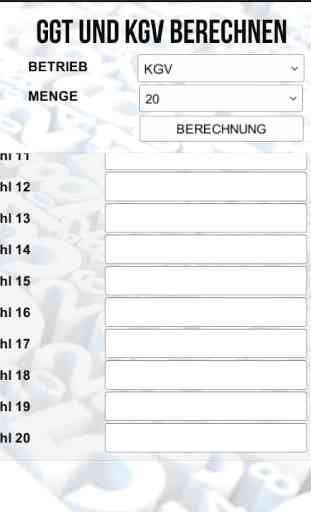GGT und KGV Rechner
Biggest common divisor (gcd)
The gcd gives the largest possible number by which two or more numbers are divisible. A number is divisible by another number if the division by that exact number yields an integer.
In the following two methods are presented, with which one can determine the gcd. Determination of the gcd by listing all divisors
This method is easy to understand, but very cumbersome for larger numbers. If one counts all divisors of the numbers whose gcd one should determine, then the gcd can be read off.
One recognizes now the divisors of 8, these are: 1,2,4,8
If the divisors of 12 are determined by the same procedure, we obtain: 1,2,3,4,6,12
Now you look at the largest of these divisors, which appears in both lists (which both have in common). In this case, that would be the number 4. The 4 is thus gcd of 8 and 12.
Mathematically one writes this: ggT (8, 12) = 4
This process is problematic for larger numbers, which have many dividers.
Determine the gcd by prime factorization
A slightly more complicated but applicable method for larger numbers is the determination of prime factors of the numbers from which the gcd is to be formed. The numbers are each decomposed into their prime factors and then determined all the factors that appear in both decompositions. These factors are then multiplied.
If you do not know the prime factorization yet, you should first look at the lesson on primes and prime factorization.
These methods can also be used for the gcd of more than two numbers.
If the numbers do not have a common divisor (so only division: 1 works), we use the word "divisive".
Application of the gcd
The gcd can be used inter alia to reduce fractions. If one has determined the gcd of numerator and denominator of a fraction, one can shorten this fraction with the gcd.
The kgV indicates when the multiples of two numbers meet for the first time.
Again, there are two methods. Which are similar to the methods for calculating the gcd.
Determination of the kgV by listing the multiples
Again, you can determine a few multiples and then look, if the multiples of the numbers are the same.
Unlike the gzT, there is always a kgV.Use of the kgV
If you want to add two fractions whose denominators are different, you have to make the denominator the same name. For this one needs a common multiple of the two denominators. So you can use the kgV to help.
The fractions can thus be both extended so that 210 stands in both denominators.
To know what value to expand, use the previously determined prime factorization to break the denominators into factors:
5/30 + 14/42 = 5 / (2 * 3 * 5) + 14 / (2 * 3 * 7)
If one wants to make these fractions of the same name, then one has to expand in each case with the prime factors that are present in the other denominator but not in their own denominator.
5 / (2 × 3 × 5) + 14 / (2 × 3 × 7) = (5 × 7) / (2 × 3 × 5 × 7) + (14 × 5) / (2 × 3 × 7 × 5) ) = 35/210 + 70/210 = 105/210
The kgV can also be determined by several numbers, you can also use both methods.
kgV of several numbers
The calculation method is the same as previously known, except that we now consider another number:
28 = 2 · 2 · 7
25 = 5 · 5
40 = 2 × 2 × 2 × 5
kgV = 2 · 2 · 2 · 5 · 5 · 7 = 1400
Knowledge in short form
greatest common divisor
The gcd gives the largest possible number by which two numbers are divisible.
Calculation: Divide numbers into prime factors and summarize the same prime factors.
We write: gcd (8, 20) = 4
If the numbers do not have a common divisor (so only division: 1 works), we use the word "divisive".
least common multiple
The kgV indicates when the multiples of two numbers meet for the first time.
Calculation: Divide numbers into prime factors and summarize prime factors (each in the highest number).
We write: kgV (6, 8) = 24
The gcd gives the largest possible number by which two or more numbers are divisible. A number is divisible by another number if the division by that exact number yields an integer.
In the following two methods are presented, with which one can determine the gcd. Determination of the gcd by listing all divisors
This method is easy to understand, but very cumbersome for larger numbers. If one counts all divisors of the numbers whose gcd one should determine, then the gcd can be read off.
One recognizes now the divisors of 8, these are: 1,2,4,8
If the divisors of 12 are determined by the same procedure, we obtain: 1,2,3,4,6,12
Now you look at the largest of these divisors, which appears in both lists (which both have in common). In this case, that would be the number 4. The 4 is thus gcd of 8 and 12.
Mathematically one writes this: ggT (8, 12) = 4
This process is problematic for larger numbers, which have many dividers.
Determine the gcd by prime factorization
A slightly more complicated but applicable method for larger numbers is the determination of prime factors of the numbers from which the gcd is to be formed. The numbers are each decomposed into their prime factors and then determined all the factors that appear in both decompositions. These factors are then multiplied.
If you do not know the prime factorization yet, you should first look at the lesson on primes and prime factorization.
These methods can also be used for the gcd of more than two numbers.
If the numbers do not have a common divisor (so only division: 1 works), we use the word "divisive".
Application of the gcd
The gcd can be used inter alia to reduce fractions. If one has determined the gcd of numerator and denominator of a fraction, one can shorten this fraction with the gcd.
The kgV indicates when the multiples of two numbers meet for the first time.
Again, there are two methods. Which are similar to the methods for calculating the gcd.
Determination of the kgV by listing the multiples
Again, you can determine a few multiples and then look, if the multiples of the numbers are the same.
Unlike the gzT, there is always a kgV.Use of the kgV
If you want to add two fractions whose denominators are different, you have to make the denominator the same name. For this one needs a common multiple of the two denominators. So you can use the kgV to help.
The fractions can thus be both extended so that 210 stands in both denominators.
To know what value to expand, use the previously determined prime factorization to break the denominators into factors:
5/30 + 14/42 = 5 / (2 * 3 * 5) + 14 / (2 * 3 * 7)
If one wants to make these fractions of the same name, then one has to expand in each case with the prime factors that are present in the other denominator but not in their own denominator.
5 / (2 × 3 × 5) + 14 / (2 × 3 × 7) = (5 × 7) / (2 × 3 × 5 × 7) + (14 × 5) / (2 × 3 × 7 × 5) ) = 35/210 + 70/210 = 105/210
The kgV can also be determined by several numbers, you can also use both methods.
kgV of several numbers
The calculation method is the same as previously known, except that we now consider another number:
28 = 2 · 2 · 7
25 = 5 · 5
40 = 2 × 2 × 2 × 5
kgV = 2 · 2 · 2 · 5 · 5 · 7 = 1400
Knowledge in short form
greatest common divisor
The gcd gives the largest possible number by which two numbers are divisible.
Calculation: Divide numbers into prime factors and summarize the same prime factors.
We write: gcd (8, 20) = 4
If the numbers do not have a common divisor (so only division: 1 works), we use the word "divisive".
least common multiple
The kgV indicates when the multiples of two numbers meet for the first time.
Calculation: Divide numbers into prime factors and summarize prime factors (each in the highest number).
We write: kgV (6, 8) = 24
Category : Finance

Related searches




